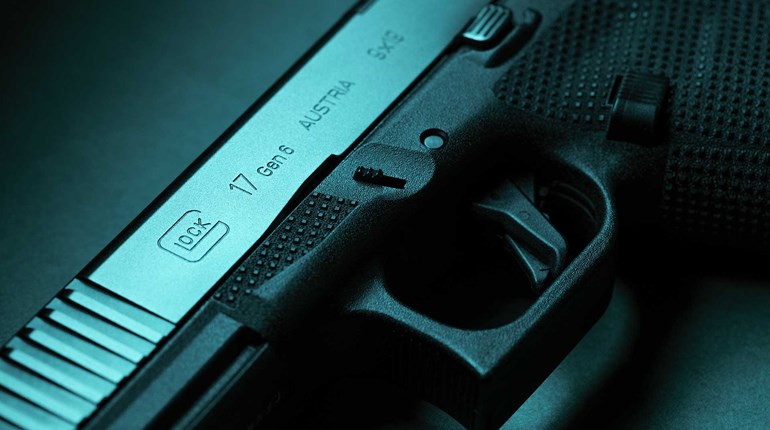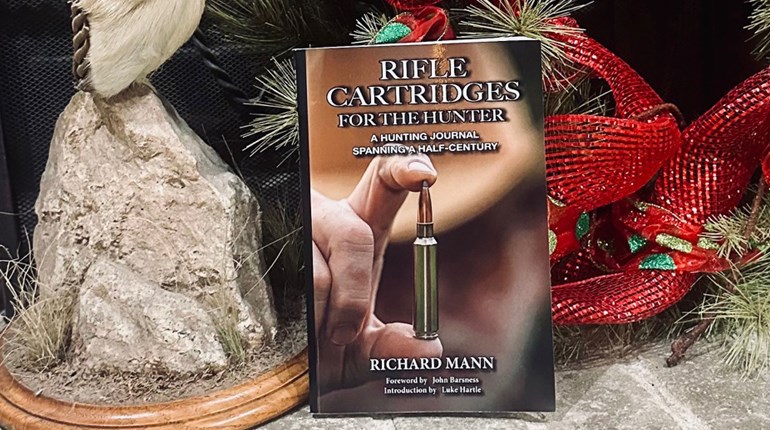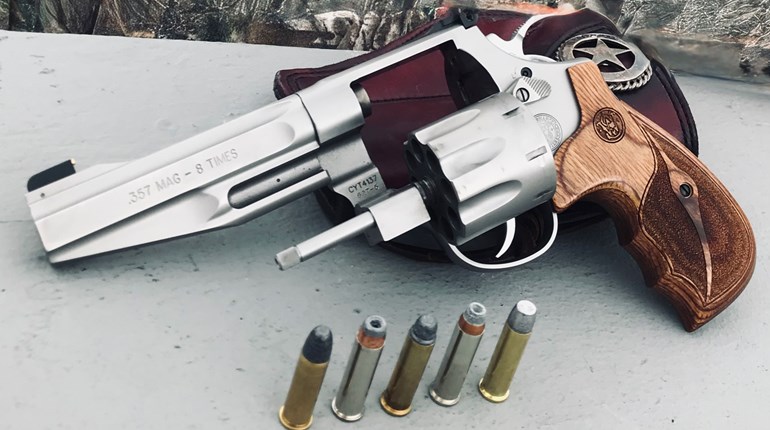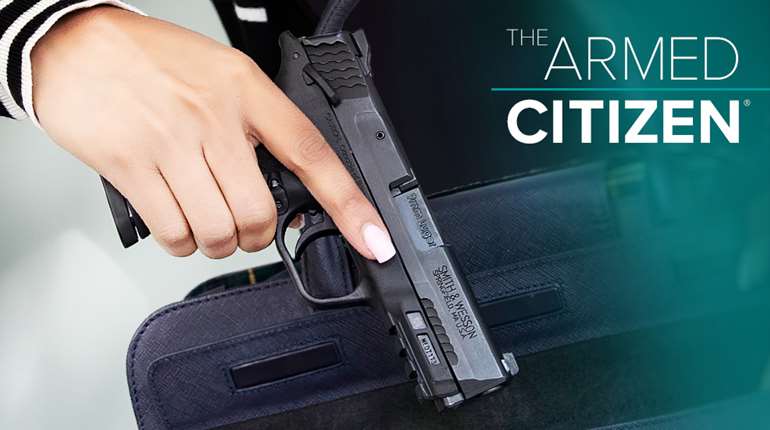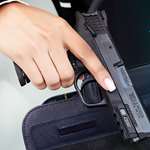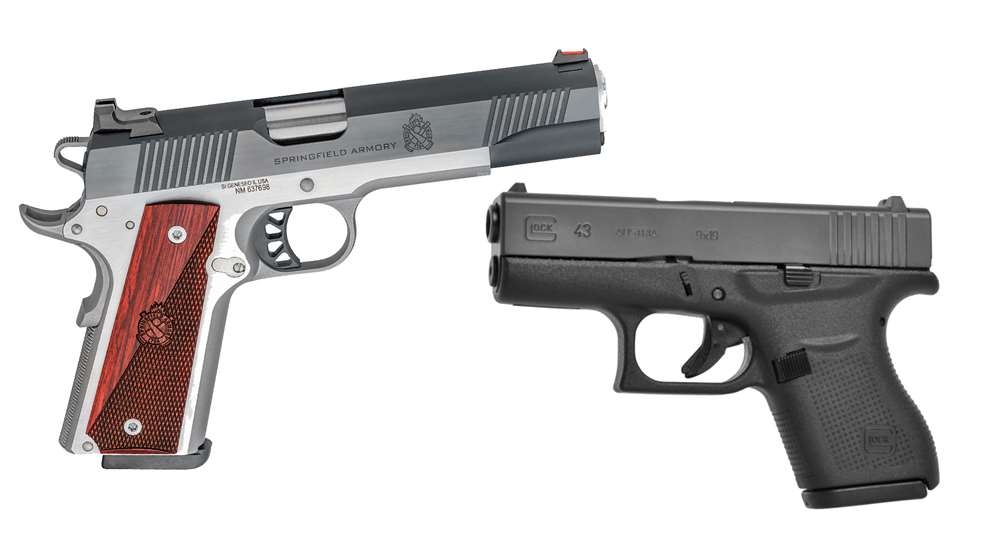
Today’s NRA Woman has a choice between hammer-fired semi-automatic pistols and striker-fired semi-automatic pistols. Hammer-fired guns have been around since the 1800s. These early hammer-fired guns were single-action revolvers. The single-action revolver soon gave way to the double-action revolver. The double-action revolver soon found competition with the single-action-hammered semi-automatic pistol. In 1890 John Browning developed the predecessor of the modern-day 1911 single-action, semi-automatic pistol.
Modern hammer-fired semi-automatic pistols can be either single-action (SA), double-action/single-action (DA/SA) or double-action-only (DAO). These pistols filled the niche of duty and personal protection firearms up until the early 1980s. Since then, striker-fired semi-automatic pistols have claimed their share of the market for duty and personal protection firearms. Glocks were not the first striker-fired pistols, but it was this particular make that led the way of pistol evolution. Striker-fired firearms have not replaced hammer-fired firearms, yet they have a secure place in the semi-automatic world.

Hammer-fired
It is easy to distinguish a hammer-fired gun from a striker-fired gun. The hammer-fired has a visible hammer at the rear of the slide. Gun owners who prefer the hammer-fired pistol usually point to the fact that these types of pistols usually have at least one external safety to help prevent accidental discharges.
In hammer-fired firearms, the hammer, when released by the trigger, rotates forward and strikes the firing pin. The firing pin is then driven into the cartridge primer. This begins the ignition process to propel the bullet down the barrel.
The trigger on a hammer-fired pistol works one of two ways, depending on the type of gun. The first type simply drops the hammer. This type of hammer-fired is called a single-action firearm. The second type performs two functions. The trigger pull on this type of gun cocks the hammer as the trigger is pulled. The trigger then reaches the maximum pull that releases the hammer to strike the firing pin.
Single-Action Hammer-fired 
The most well-known hammer-fired pistol is the 1911. To fire this type of semi-automatic pistol, the hammer must be cocked, or locked in the rear position. Once the loaded magazine is inserted into the gun, the slide must be racked to the rear and allowed to slam closed. This cocks or locks the hammer to the rear. When the trigger is pulled, the hammer rotates forward and strikes the firing pin.
The design of the single-action semi-automatic pistol is for it to be in the ready mode—in other words, this type of firearm is carried “cocked and locked.” There are usually one or two manual safeties on this type of action. One safety usually must be manually disengaged, and the other is usually a passive safety on the grip. The passive safety is disengaged when the hand is placed on the grip.
Double Action/Single-Action Hammer-fired 
The double/single hammer-fired is the most common of the hammer-fired pistols. When using this type of semi-automatic pistol, the hammer does not have be cocked or locked in the rear position. Once the loaded magazine is inserted into the gun, the slide must be racked to the rear and allowed to slam closed. This cocks or locks the hammer to the rear. Unlike the single-action pistol, there is a decocking lever that drops the hammer. When the hammer is de-cocked and it falls forward, it does not fire.
This type of firearm is carried with the hammer down. When the trigger is pulled, the hammer rotates back to cock. When it reaches its maximum pull, it drops forward and strikes the firing pin. (This is the double action part of the firing sequence.) Every time the pistol fires, the slide locks the hammer to the rear. Each additional shot is now performed in single action mode, because all the trigger does from then on is to release the hammer. If the firing sequence is stopped before the magazine is empty, the pistol should be de-cocked to place in carry mode.
There are many benefits to the double/single action hammer-fired pistol. The first is that these firearms usually carry a double-stack magazine, unlike the single-action hammer-fired pistol. Like the single-action pistol, the double/single action has one to two safeties to help prevent accidental discharges.
The downside to this type of pistol is that the first shot is in double action mode, so the initial trigger pull is usually a harder pull than the subsequent shots. This can cause inconsistent shot placement between the first and second shots.
Double-Action-Only Hammer-fired
When using this type of semi-automatic pistol, the hammer does not have be cocked, or locked in the rear position. Once the loaded magazine is inserted into the gun, the slide must be racked to the rear and allowed to slam closed. This cocks and de-cocks the pistol in the same motion.
This firearm is carried with the hammer down. Each time the trigger is pulled, the hammer rotates back to cock, and then when it reaches its maximum pull, it drops forward and strikes the firing pin. This is a double- action firing sequence.
The benefits of the double action only semi-auto pistol are the same as the double/single action hammer-fired pistol. The downside is that every pull can be harder than the trigger pull of the single-action hammer-drop pistol.

Striker-Fired
The most visible difference between striker-fired and hammer-fired pistols is the lack of a hammer. In a striker-fired pistol, the firing pin does not have to be hit to strike the primer of the cartridge. With a striker-fired pistol, pulling the trigger to its maximum pull releases the firing pin itself. In a hammer-fired pistol, the trigger releases the hammer, which in turn, strikes the firing pin.
When using this type of semi-automatic pistol, there is no hammer to cock. Once the loaded magazine is inserted into the gun, the slide must be racked to the rear and allowed to slam closed. This partially cocks the spring-loaded firing pin. The pistol is not fully cocked until the trigger is pulled to its maximum pull length. With a striker-fired pistol, if the firing pin drops without pulling the trigger, the firearm does not discharge. This results in a light strike and should not be sufficient enough to ignite the primer.

There are many benefits to a striker-fired pistol. Many of these types of firearms have a double-stack magazine for a larger ammunition capacity. Another benefit of the striker-fired pistol is the overall weight of the gun. These guns are much lighter because they are made of polymer components. These pistols also tend to be more streamlined, which aids in concealment.
The best benefit of the striker-fired pistol is its ease of operation. They are easier to deploy since they do not have protruding components like a hammer that can hang up on clothing. Additionally, most striker-fired pistols do not have an external safety to disengage before firing. This is very important in a stressful situation where you may need to protect your life.
That lack of an external safety is a benefit to some, while others may want some type of visible safety on their firearm. (Striker-fired pistols have safeties, but they are all internal; they prevent the firearm from discharging in the event that it is dropped.)
Today’s gun owners have many options available to them. There are many pros and cons to each of these options; as the consumer, you’ll need to choose the gun that best fits your needs.












